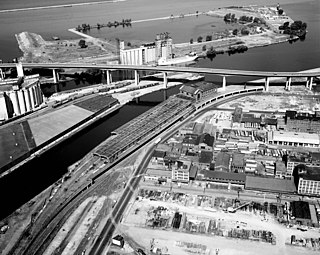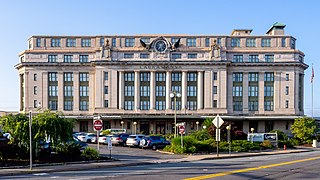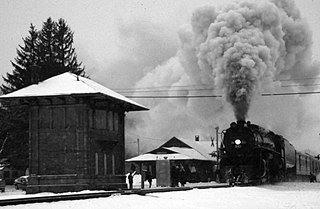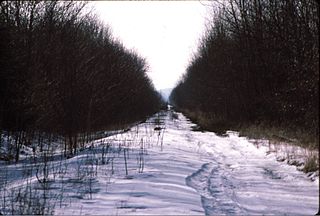The Erie Railroad was a railroad that operated in the Northeastern United States, originally connecting Pavonia Terminal in Jersey City, New Jersey, with Lake Erie at Dunkirk, New York. The railroad expanded west to Chicago following its 1865 merger with the former Atlantic and Great Western Railroad, also known as the New York, Pennsylvania and Ohio Railroad.

The Delaware, Lackawanna and Western Railroad, also known as the DL&W or Lackawanna Railroad, was a U.S. Class 1 railroad that connected Buffalo, New York, and Hoboken, New Jersey, and by ferry with New York City, a distance of 395 miles (636 km). The railroad was incorporated in Pennsylvania in 1853, and created primarily to provide a means of transport of anthracite coal from the Coal Region in Northeast Pennsylvania to large coal markets in New York City. The railroad gradually expanded both east and west, and eventually linked Buffalo with New York City.

The Erie Lackawanna Railway, known as the Erie Lackawanna Railroad until 1968, was formed from the 1960 merger of the Erie Railroad and the Delaware, Lackawanna & Western Railroad. The official motto of the line was "The Friendly Service Route".

Phoebe Snow was a fictional character created by Earnest Elmo Calkins to promote the Delaware, Lackawanna and Western Railroad. The advertising campaign was one of the first to present a fictional character based on a live model.

The Delaware-Lackawanna Railroad is a shortline railroad operating in Northeastern Pennsylvania, especially the Scranton area.

The Lackawanna Cut-Off was a rail line built by the Delaware, Lackawanna and Western Railroad (DL&W). Constructed from 1908 to 1911, the line was part of a 396-mile (637 km) main line between Hoboken, New Jersey, and Buffalo, New York. It ran west for 28.45 miles (45.79 km) from Port Morris Junction in Port Morris, New Jersey, near the south end of Lake Hopatcong about 45 miles (72 km) west-northwest of New York City, to Slateford Junction in Slateford, Pennsylvania near the Delaware Water Gap.

The Metro Rail Maintenance Yard or "South Park Terminal" houses Buffalo Metro Rail's cars in a train shed at the former Delaware, Lackawanna and Western Railroad terminal in the Cobblestone District of Buffalo, New York. The property is located at the southernmost fringe of the Central Business District. The station was built in 1917, and was designed to handle both steam trains and steamships. The storage and maintenance facility was converted to its present condition in 1982, following the demolition of the former main terminal concourse building "headhouse" of the DL&W Terminal in 1979.

Newark Broad Street station is a New Jersey Transit commuter rail and light rail station at 25 University Avenue in Newark, New Jersey. Built in 1903, the station's historic architecture includes an elegant clock tower and a brick and stone façade on the station's main building. In June 1984, the station was added to the National Register of Historic Places in recognition of its historical significance.

The Radisson Lackawanna Station Hotel, which was built as the Delaware, Lackawanna and Western Railroad Station, is a French Renaissance-style building in Scranton, Pennsylvania.

The Lake Cities was a passenger train operated by the Erie Railroad and successor Erie Lackawanna Railway between Chicago and Jersey City, New Jersey and then Hoboken, New Jersey.

Railroad Terminal Historic District is a national historic district in Binghamton in Broome County, New York. The district includes 19 contributing buildings. Four of the buildings were directly related to Binghamton's rail passenger and freight operations, including the passenger station. Five buildings were built as warehouses, and ten were built to house retail activities with residential or office uses on the upper floors. The buildings were built between 1876 and 1910, with a major addition to one of them completed in 1932. This Delaware, Lackawanna and Western Railroad passenger station, with its Italian Renaissance campanile, was built in 1901. For most years of passenger service to Binghamton, Delaware and Hudson Railway and Erie Railroad trains used a different station 150 yards away.

East Stroudsburg is an historic train station built by the Delaware, Lackawanna and Western Railroad in 1856. The station served as the local stop for both East Stroudsburg and Stroudsburg, Pennsylvania. The depot, recently known locally as the Dansbury Depot for the restaurant that used the building, is located on Crystal Street in East Stroudsburg. Service to East Stroudsburg ended on January 6, 1970, when the Erie Lackawanna Railway discontinued the Lake Cities. A proposal is currently in place to extend NJ Transit service to a rebuilt East Stroudsburg station. In spring 2021, Amtrak announced plans for potential New York–Scranton route. It is currently used by some of Steamtown National Historic Site's excursion trains.

Tobyhanna station is a proposed NJ Transit commuter rail station that is located in Coolbaugh Township, Monroe County, Pennsylvania in the United States. The station forms part of a site owned by a number of public and private entities including the Pennsylvania Northeast Regional Railroad Authority.

Pocono Mountain is a proposed New Jersey Transit Rail Operations (NJT) station located in Coolbaugh Township, Monroe County, Pennsylvania and is part of a site that was formerly utilized as a summer camp. The proposed station site, which will include a 1,000-space surface parking lot, is located northwest of a multi-phased planned development for this area. Access will be from Pennsylvania Route 611 via Pocono Municipal Road/Mount Pocono Road and a local access road and the platform would be situated east of the track.

Port Morris Junction is the railroad connection between NJ Transit's Montclair-Boonton Line and the Lackawanna Cut-Off. Opened in 1911 by the Lackawanna Railroad, it is in the Port Morris, New Jersey section of Roxbury Township, New Jersey, south of Lake Hopatcong.

The Nickel Plate Limited, later known as the City of Cleveland and City of Chicago, was a passenger night train operated by the New York, Chicago and St. Louis Railroad between Chicago and Buffalo, New York via Cleveland, Ohio, with through service to Hoboken, New Jersey via Binghamton and Scranton and the Delaware, Lackawanna and Western Railroad for the Buffalo-Hoboken segment.

The Lackawanna Cut-Off Restoration Project is a New Jersey Transit and Amtrak effort to restore passenger service to the Lackawanna Cut-Off in northwest New Jersey.

Andover is a planned New Jersey Transit passenger railroad station in Andover Township, in Sussex County, New Jersey, United States, providing service on its Lackawanna Cut-Off line. The line remains under construction. The station will be built at a site on Andover's Roseville Road, about 1.1 miles (1.8 km) from U.S. Route 206 and about 0.9 miles (1.4 km) from County Route 517. On the rail line, it will be located about 7.3 miles (11.7 km) west of Port Morris Junction.

Blairstown was one of the three original Delaware, Lackawanna and Western Railroad stations on the Lackawanna Cut-Off rail line in northwestern New Jersey. Built by contractor Hyde, McFarlan & Burke, the station opened in 1911. Most passenger trains, such as the Lackawanna Limited and, later, the Phoebe Snow, plus the Twilight/Pocono Express and the Westerner/New Yorker stopped at Blairstown, which also sold commuter tickets.

The Erie Limited was a streamlined passenger train operated by the Erie Railroad between Jersey City, New Jersey and Chicago, Illinois via the Southern Tier. It operated from 1929 to 1963. After the merger of the Erie and the Delaware, Lackawanna and Western Railroad (DL&W) in 1960 it was known as the Erie-Lackawanna Limited. Once the premier passenger train on the Erie, repeated service reductions in the 1950s and 1960s left it a shell of its former self. The Phoebe Snow replaced it in 1963.























